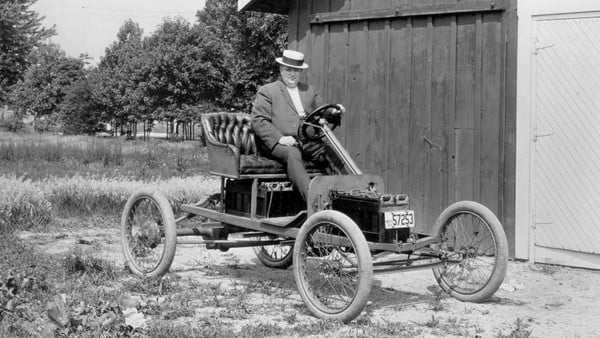Global Courant 2023-04-16 12:01:06
Thomas Alva Edison and Henry Ford were teacher and disciple. They shared years at Edison Electric, where the student rose to head of engineering in just 36 months. They were made of the same material, the kind that mixes vision of the future, creativity and business. They were favorite children of the United States. It was not surprising, then, that at the beginning of the 20th century they came together in a venture that is still rabidly current today: they wanted to develop an efficient electric car.
The technology was already on the decline compared to the internal combustion engine, but Edison seemed to have the secret to turning it around and making it a success. However, not even the union of two brilliant minds managed to overcome the failure and difficulties inherent in that sector of the automotive industry. The tragedy, a fire that lit up the sky at dawn, ended up burying their aspirations under twisted iron.
In 1914, Ford announced that he was working on a project for electric mobility. Although he spoke with extreme caution, even today his statements read as a promising path that, in his way, could have changed the world. Because who, if not him, to combine the benefits of the mass production system – already launched with the manufacture of the T model, two years earlier – and the technology on which his friend worked: iron batteries nickel.
Thomas Edison and Henry Ford, teacher and disciple..
“Within a year, I hope, we will start manufacturing an electric car. I don’t like to talk about things that have a year ahead, but I’m willing to tell you something about my plans”, said the magnate in an interview with The New York Times, on January 11, 1914. His link with Edison would bring a vehicle “cheap and effective”. Despite the precautions of the case, he was encouraged to affirm that “the path to success” was “clear”.
Fatality and the impossibility of circumventing the restrictions that continue to hinder the production of electric cars caused his project to short-circuit and, lost in the fire, never see the light.
Good, nice and cheap: the conditions for Ford’s success for its electric car
The Detroit company had already existed since 1903. Those first years of the 20th century were marked by a transition of energy sources in which even the electric motor seemed to be ahead of the competition. The times of steam were over, although some shots powered by that system could be seen on the streets. However, it is estimated that in 1900 almost 30% of the units manufactured were electric.
Although there is no consensus on which was the first electric car in history, it was recorded in the books that a car powered by this energy source -“Jamais Contente”, its name- became the first to cross the 100-meter barrier. km/h, in 1899. This was the state of things at that time of coexistence between creatures with such dissimilar hearts.
The stroke of luck for combustion engines was given by Ford with the Model T, which in 1912 economized on the development of cars and exploited the new system of mass production. This milestone is often cited as the entry of cars into the life of the European and North American middle class.
Clara Ford pushed the electric car project, but it did not have an echo.
It was also translated as a hard blow for the electricity industry, which both knew as customers (their wives, Mina and Claire, had their respective EV) and in the case of the inventor of the light bulb also as a manufacturer (he made three prototypes in 1912 , shortly before the appearance of the T model).
The situation was already irreversible. Nickel iron batteries, replacing lead-acid batteries, were expensive, dangerous, bulky, and too slow to charge. So, the businessman made one last move with a wink at Edison.
Henry Ford and Thomas Edison in one of their usual talks.
In 1914, Henry was 51 years old; Thomas, 67. A genius as ambitious as he was irrepressible, parallel to his short stint at Edison Electric he explored improvements in reliable cars on his own. It was so that he made his own way, separated from the “Wizard of Menlo Park”, with his own company and a different technological bet. Two decades later they met again.
The already successful businessman knew that his colleague had been working with the new type of batteries to eliminate its drawbacks. With almost blind confidence, he organized a team of engineers from his company to finally find the ultimate electric. The conditions that he set for them could be summed up in a classic formula: “good, pretty and cheap”.
“Good” then meant that autonomy made possible its adoption by a public that was beginning to turn to the streets on wheels. It was not enough with short tours. Now it was necessary to look at the feasibility that vehicles could face longer journeys without leaving drivers on foot halfway.
Henry Ford and Thomas Edson with Harvey Firestone, the founder of the tire company.
“Pretty” meant that the batteries were small enough not to alter the design of the brand’s creations, still reminiscent of horse-drawn carriages. According to the improved version of Edison’s new battery, they could be hidden under the seat.
And “cheap” was translated as a border line: the one of 500 dollars, 100 less than the brand new model of the rhombus. According to official forecasts, the new creation would be ready in 1915. It never reached the streets.
Why Ford had to put its Edison division on hold for a century
One of the shortcomings of nickel iron batteries was safety. When charging, they gave off hydrogen, an extremely dangerous substance at that time. Although the man of the 1,093 inventions investigated to reduce the risk, his project received one last impact at the end of 1914 from which he could not recover.
The sky of West Orange, in New Jersey, lit up red in the early hours of December 10 due to the gigantic fire that consumed the plant that had been built in the center of the city. It all started with the rapid burning of film material in a warehouse.
The stories speak of tongues of fire that, mixed with the dense smoke, rose 30 meters. Five entire blocks, a dozen buildings, were reduced to rubble before the pitiful gaze of the inventor, who watched the flames from a window of the Battery Factory.
Ford is behind the wheel and Edison in the back seat.
Although the factory where the nickel iron parts were made was left intact, for old Thomas the priorities changed. Losses were estimated at $7 million. “There is something valuable in the disaster: all our mistakes were burned. Thank God we can start again, ”he said hours later. Indeed, the firm’s 7,000 employees began rebuilding the next day.
Gone was the million-dollar investment that he dedicated for an entire decade to improve iron-nickel batteries. The $1.5 million Ford had contributed to the cause was also reduced to ashes.
The Detroit tycoon, however, did not do badly. Another factor in the failure of the electric car was a new impetus for his own company: the electric starter. His discovery also came at the end of 1914 and made it possible to make fuel-powered vehicles independent of the use of the crank to get going. It was a tortuous and slow job that, thanks to this innovation, was reduced to the span of a flash.
Ford’s assembly line in 1913.
Despite the investigation, Edison could not pay off the autonomy debt either: he promised to reach 160 kilometers but the minimum 80 kilometers were scarce. Point in favor of internal combustion engines, especially with the construction of an extensive network of routes and roads in the United States after the First World War.
Finally, the discovery of oil in Beaumont (Texas) collapsed the price of a barrel and, as a consequence, took away from the electric driver the comparative advantage of low energy replacement cost.
Ford Mustang Mach-E, the first electric model mass-produced by the brand.
Thus, among the rubble of the fire were the few motivations of the oval brand to enter the mass production of cars by electricity. It remained in the rearguard of the approximations that the industry insinuated in the sixties (with the rise of concern for the environment) and in the seventies (due to the increase in the price of raw materials in the 1973 oil crisis). .
It was not until 1998 that it released its first electric car, a model of the Ranger pick-up equipped with a Siemens drive. Finally, in 2017 the names crossed again. Team Edison is the name of the division that Ford dedicates to the design of vehicles that work with electricity. A marketing and branding move that paid tribute to the friendship of the two powerful businessmen, two American symbols that at least once could not get the world to play in their favor.




